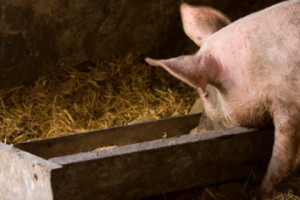According to the Department of Agriculture, about one out of every 20,000 chicken eggs produced in the U.S. has a high risk of being contaminated with Salmonella bacteria. Not all kinds of Salmonella are harmful, but some are, notably S. enteritidis, which has been associated with eating raw or undercooked eggs. This  and other pathogenic Salmonella strains can cause diarrhea, stomach cramps, fever, and—in some instances—death.
and other pathogenic Salmonella strains can cause diarrhea, stomach cramps, fever, and—in some instances—death.
Those most vulnerable to salmonellosis are infants, preschoolers, pregnant women, the elderly, and anyone who has a compromised immune system.
Properly cooking chicken eggs—such as by hard-boiling them—kills Salmonella.
So does pasteurizing them. Right now, a hot-water-immersion process is apparently the only technique used commercially in this country to pasteurize fresh “shell” eggs (eggs that are sold in-the-shell, instead of as a liquid product, for example). Many supermarkets offer these eggs as a specialty item in their dairy case.
But the hour-long immersion process may change qualities of these raw eggs, perhaps making them less satisfactory to discerning home cooks and restaurant chefs alike. Studies led by Agricultural Research Service chemical engineer Dave Geveke have resulted in a better, faster way to pasteurize raw shell eggs without ruining their taste, texture, color, or other important characteristics.
Geveke’s tests with some 4,000 fresh shell eggs indicate that heating them with the energy from radio waves, or what’s known as radiofrequency (RF) heating, followed by a comparatively brief hot-water bath, can kill harmful microbes without lessening the quality of the treated eggs.
Each raw egg is positioned between two electrodes that send radio waves back and forth through it. Meantime, the egg is slowly rotated, and its shell is cooled by spraying it with water—to offset some of the heat created by the radio waves.
Unlike conventional heating, RF heating warms the egg from the inside out. That’s critical to the success of the process. It means that the dense, heat-tolerant yolk, at the center of the egg, receives more heat than the delicate, heat-sensitive white (albumen).
The hot-water bath comes next. The warmth of the bath helps the yolk retain heat, to complete the pasteurization. The heat from the water also pasteurizes the white, without overprocessing it.
From start to finish, the treatment takes around 20 minutes, making it about three times faster than the hot-water-immersion technique. And in tests using a research strain of Salmonella, Geveke showed that the RF-based process killed 99.999 percent of the Salmonella cells.
Before the treatment, Geveke’s team artificially infected the eggs by poking a small hole in the top of each, injecting the Salmonella into the egg via a glass syringe, then sealing the hole with a droplet of quick-setting epoxy glue. In nature, a hen’s eggs can become contaminated with Salmonella if her ovaries are infected with it.
The idea of using RF heating to kill pathogens in foods isn’t new. But using RF heating to kill pathogens in eggs is novel. And Geveke and his colleagues are evidently the first to pair RF heating with a hot-water bath to pasteurize raw shell eggs.
A provision of the U.S. Food and Drug Administration’s Food Code may contribute to growth of the raw-pasteurized-egg market. Already adopted by some states, the code specifies use of raw pasteurized eggs, or other pasteurized egg product, in place of unpasteurized eggs when foods such as Caesar salad are served to at-risk populations or to people who receive meals through “custodial care-giving environments” such as nursing homes, hospitals, or eldercare centers.
Though the specialty market is an obvious application of the RF-heating process, it could of course be used to pasteurize all of the more than 221 million fresh shell eggs produced in the United States every day. This would undoubtedly add to processors’ costs, but might be a convenience for shoppers and would add an extra margin of safety to all fresh shell eggs—not just the specialty product, Geveke points out.
Commercial use of the RF-based method is at least a year or so away. Geveke expects to begin pilot-scale tests this year. After that, regulatory approval would be needed.
 Nisswa, said Lion’s club president Duane Blanck.
Nisswa, said Lion’s club president Duane Blanck.


